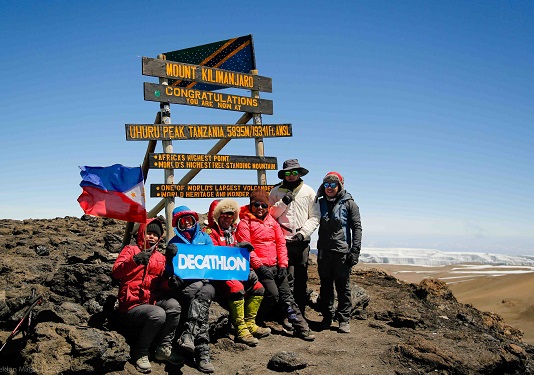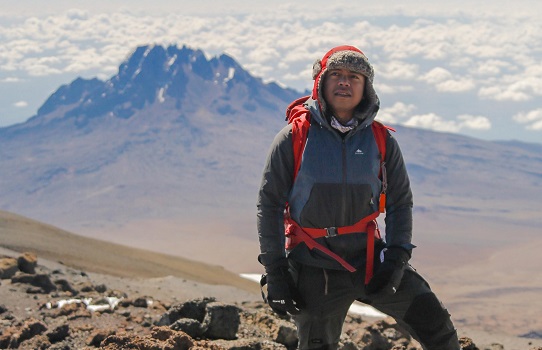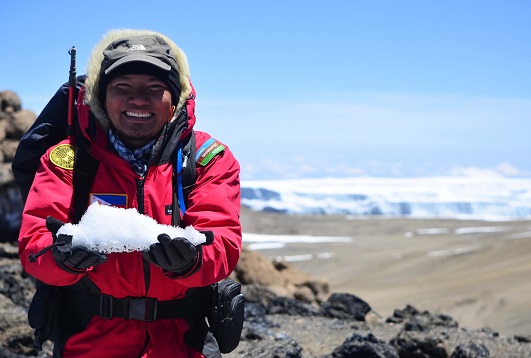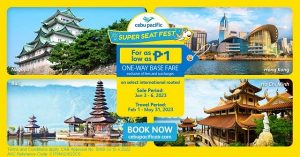How to Climb Mt. Kilimanjaro, the Golden Roof of Africa
Four in the morning, pitch-black and it’s 20 degrees below zero. There’s iced snot on my face but I don’t care.
The world is limited to what my headlamp illuminates, all movement restricted by six layers of clothing. I crane my neck at a column of headlamps extending to the stars. The gradient’s so steep I can’t discern where the headlamps end and where the stars begin.
For a while there’s no sound but the crunch of our team’s boots on frozen ice. The wind starts to howl. Up here, the climate swings faster than a Pinoy politician before an election. Has it been six hours since we started climbing? Ten? Suddenly our ‘Kilifighters’ – tough mountain guides who surround and constantly encourage us – break into a lively Swahili song.
Welcome travelers,
To Kilimanjaro, the towering mountain,
Just walk slowly, no problem,
Like a snake, coil around her,
And you’ll summit safely.
I fantasize of a fiesta waiting at the top, with steaming lechon, adobo, taho and everything else that’s hot and warm. I check my watch. Eight hours since we left Barafu, the dry and icy basecamp where we stashed most of our gear. We don’t stop – at this elevation, it’s tantamount to rapid body heat loss. I glance at my teammates and they too are trying to survive the freezing winds. Gradually the dawn reveals a windswept world of rock, of ice.
There. Up ahead, a final push away, lies the shoulder of Kilimanjaro, the highest mountain in Africa and one of the world’s Seven Summits. Gritting our teeth, we climb.

Preparing for Your Kilimanjaro Climb
Mt. Kilimanjaro is one of the planet’s most iconic mountains, so popular it’s in the intro of The Lion King.
It towers over northern Tanzania, near the Kenyan border in a slice of Africa known to geologists as the Great Rift Valley. In actuality, Kilimanjaro is an extinct volcano that rises 19,341 feet (5,895 meters) – almost twice the height of Mt. Apo, which at 9,692 feet (2,954 meters), is the highest peak in the Philippines. Fortunately, Kilimanjaro hasn’t blown her top in 360,000 years, almost before Juan Ponce Enrile was born.
Dubbed as ‘The White Mountain’, Mt. Kilimanjaro is one of the world’s Seven Summits, the highest mountains on each continent. The other summits include Everest in Asia, Aconcagua in South America, Denali in North America, Elbrus in Europe, Vinson Massif in Antarctica plus either Kosciuszko in Australia under the Bass list or Carstensz Pyramid in Indonesia under the Messner list.
Just half of the roughly 35,000 climbers who attempt to scale Kilimanjaro’s sheer slopes succeed, but you don’t need to be a rope-toting Sherpa to do it. For the average Filipino, summiting Kilimanjaro just requires years of saving, months of preparation and anywhere from five to ten days of steady climbing. Many Pinoys have successfully reached her frozen rim.
You can too with these tips.
1. Choose your own adventure. Your preferred route and outfitter might very well determine how enjoyable and successful your trip will be. We chose Top Climbers Expeditions, a company run by pros with a solid success rate for summiting the mountain (we all made it).
From the Philippines, you’ll fly nearly 10,000 kilometers to Dar es Salaam, the quaint, seaside capital of Tanzania. For a slice of local flavor and culture, we recommend exploring its markets, museums and ivory beaches before flying to the jump-off cities of Arusha or Moshi, some 600 kilometers away.
There are seven established routes up Mt. Kilimanjaro and two trails for descending and resupplying expeditions. They vary from easy Marangu, where climbers can sleep in huts, to the more brutal and direct Umbwe Route.
“We chose and highly recommend the Lemosho Route, the most scenic trail with the highest summit success rate due to its gradual ascent. We measured the route at around 70 kilometers which takes about eight days to complete, from the jump-off at Lemosho Gate to its conclusion at Mweka Gate,” explains Rofil Sheldon Magto, leader of our successful expedition.
Over eight days, you and your climb-kada will pass through cool pine plantations, misty cloud forests, wet moorlands, dry alpine deserts and the frozen alpine zone, where sunrays and wind dance like fire and ice.
While Kilimanjaro can be climbed year-round, the driest and safest climbing windows would either be from December to mid-March or from July to October. Climbing in the wet season means slogging through heavy snowfall and slushy mud – not much fun and not too safe for you or your guides.
Leave ample leeway when crafting your itinerary, adding extra days to anticipate instances when flights are interrupted, delayed or missed. Some of our teammates were stuck for three days in another country when a freak snowstorm canceled the region’s connecting flights. Worse, they weren’t issued entry VISAs, so they had to survive at the airport like Tom Hanks in The Terminal.
2. Pick your climb-kada wisely. “When high-altitude sickness, crazy physical challenges and inclement weather set in, you’ll be grateful for the company of your most trusted climbing buddies,” explains Rofil. “They’ll inspire you and your team to reach the summit, while taking care of you when you aren’t feeling well physically, mentally and emotionally. They’ll also probably laugh when you fall flat on your butt! Kilimanjaro is no walk in the park so you should look for buddies with similar goals. Climbers who you’ll enjoy trekking with, who’ve got your back no matter what happens.”
3. Save up. Prepare a realistic budget. Your two biggest expenses would be roundtrip flights from the Philippines to Dar es Salaam, capital of Tanzania, plus the cost of your climbing outfitter. “Be wary of cheaper outfitters, which may scrimp on vital services,” warns Rofil. Kilimanjaro isn’t cheap, but it’s far more affordable than the other Seven Summits. A budget of PHP200,000 (USD3.6K) should be enough to cover a climber’s roundtrip flights, travel and climb insurances, VISAs, accommodations, food, tips and pasalubong.
“Don’t bring PHP200,000 or its USD equivalent in cash to reduce overall risk. Africa – like any place on Earth – is not bereft of crime. Pay for what you can in advance, bring secure credit and debit cards and stash your physical cash in various bags.”
Lastly, remember that Africa is a region where tipping is highly appreciated. Our team of six climbers pooled together our resources to give each of our 22 porters and guides a fair tip. Tipping generously not only helps hardworking Africans provide for their families – it builds a good image of us Pinoy climbers.
4. Logistics, logistics, logistics. This is the most critical part of your trip and one you should pore over again and again. “It may seem daunting and complex because it’s an international climb, so try to secure as many requirements ahead of time. Plane tickets, hotel accommodations and climb slots all fluctuate in price and availability so book them as soon as you can,” says Rofil. “Secure your VISAs immediately and don’t forget to get travel and outdoor insurance.”
You can secure your VISAs here while getting trip and climb insurance here.
Remember that clearing African immigration requires mandatory vaccines. Aside from complete COVID shots with boosters, you’ll need vaccines for yellow fever, malaria, typhoid, polio, diphtheria, hepatitis A and B, and tetanus. Many of these can be obtained from larger hospitals or from your local Bureau of Quarantine (BOQ). Secure these shots months ahead and remember to keep your yellow BOQ vaccination passbook with you at all times.
Always remember to check Tanzania’s official website as vaccination requirements may change over time.
5. Gear up. Buy, repair or modify your equipment ahead of time from reputable places like Decathlon and ROX. Insulated shoes, a down jacket, gloves, ear protectors and shades are must-haves.
“Don’t hesitate to invest in quality gear because your life and limb will depend on it. Merino wool for instance works great as a base layer,” recommends Pinoy Mountaineer Dr. Gideon Lasco, who summited Kilimanjaro in 2011 and has since scaled numerous international peaks. “Good trekking poles can ease knee strain while making your downhill treks easier. Every part of your body must be protected from the elements. I highly recommend bringing lip balm with SPF, polarized sunglasses with UV protection, a buff or scarf to protect your ears and neck, plus multiple layers of gloves to keep your fingers warm.”
Redundancies can save your life. I made the mistake of bringing a water bladder on summit day. Though my body heat kept the bladder itself from freezing solid, the water inside the drinking hose froze solid. Fortunately, I brought along an extra two liters of water in tumblers.
Most outfitters will also let you rent gear for the climb. Don’t scrimp, especially on cold weather equipment. Rent thermal sleeping bags, which are worth their weight in gold. If you thought your fuzzy sleeping bag was warm at the top of Mount Pulag, imagine what it will feel like at 20-degrees below zero. Proper gear spells the difference between a good night’s rest and silent suffering until sunrise.
Remember to pack some good, old-fashioned Pinoy food, guaranteed treats after weeks of African fare. One of our trip’s best moments was when our teammates Grace, Isoy, Andrei and Yelena broke out cans of Pinoy dinuguan, sardinas and bagoong. For a while our mess tent truly became home.

6. Train like a beast. Ensure you have strong legs and a solid core. Endure harsh, almost ridiculous conditions when training to build mental grit. Climbing is mostly a mental game, particularly on summit day when you’ll be climbing 18 or more hours in a single day. Climb and bond with your team to know each other’s personalities, strengths and limitations.
Our team did conditioning through a series of minor climbs in Rizal, Batangas and Laguna. Rofil, Yelena and Andrei complemented climbing with Ultimate Frisbee while Grace went for long bike rides.
My training was endless running, weights and carrying my little boy plus a 50-pound pack up and down a mountain in Rizal in the full heat of summer.
7. Polé Polé. You’ll hear this term passed on along the trail. Literally ‘slowly, slowly’ in Swahili, this approach will maximize your chances of avoiding altitude sickness and physical injury. Climbing slow and steady allows your body to gradually acclimatize to both colder temperatures and higher elevations where there’s less oxygen for your body to absorb.
Altitude sickness is the top reason people fail to summit the mountain and it’s not to be trifled with. “Acute Mountain Sickness (AMS) is a syndrome characterized by headache, nausea, vomiting, dizziness, fatigue and sleep disturbance which stems from being exposed to a hypoxic or oxygen-poor environment,” explains Dr. John Lei, a professional expedition doctor.
“Climbers are always at risk from AMS upon breaching 8,000 feet or 2,400 meters. “Higher altitudes might lead to the more serious condition known as High Altitude Cerebral Edema (HACE), characterized by altered consciousness, abnormal movements or even a coma. High Altitude Pulmonary Edema (HAPE) is another serious condition where fluid accumulates in climbers’ lungs. The best solution for all of these is to immediately descend. Supplemental oxygen and medications such as acetazolamide, paracetamol and ibuprofen will also help.”
Polé Polé, deep breathing, drinking lots of fluids, eating high-carb food and getting a good night’s rest after each trekking day is your best chance of avoiding altitude sickness. If you really want to be sure, you can take a few pills of Diamox or acetazolamide to reduce its effects. You can usually find Diamox and other mountaineering medicines in Arusha, the jump-off city for your climb.
8. Enjoy every step. “Reaching the summit is your goal, but don’t forget that your journey is as important as your destination. The whole experience is your reward for your months or years of planning and preparation. Once you set foot on the mountain, allow yourself to experience what nature has to offer. Bask in the morning sun, feel the cool breeze, listen to the sound of the forest and appreciate the beautiful wildlife you might see along the trail. This is an opportunity for you to be fully present, so take things slowly. Take the time you need to find that inner peace,” shares Rofil.
9. Capture fleeting moments. “Don’t forget to bring your camera, a lightweight tripod, enough memory cards and three or more rechargeable batteries. Snap all the photos you want and take as many candid photos to record the moments that truly made your trip meaningful. Ensure your gear is weather-proof and back up your photos once you have access to your laptop or the web when you return to the city,” says Rofil. “The last thing you’d want is to lose your precious photos and videos because of lost, low-quality or damaged memory cards. Ouch!”
10. Pasalubong and side trips. The African continent offers travelers an endless array of pasalubong options – from food to clothing, to trinkets and tribal weapons. You’ll have ample time to pick up a few mementos from your once-in-a-lifetime trip after you summit the mountain. Souvenir stores will be ready as soon as you arrive in both Dar es Salaam and Arusha.
Your Climb Outfitter should also make a short stop at a good souvenir shop upon your descent from the mountain. “Some of these shops sell Tanzanite – glittering blue jewels which are found only in Tanzania, considered up to a thousand times rarer than diamonds,” adds Rofil. “If you have extra cash, you might want to buy a stone or two as Tanzanite is much cheaper in Tanzania than anywhere else. Ask your guides to help you haggle for a good discount.”
Should you decide to continue your adventure after your climb, then the possibilities are endless. You can go on safari a day or so after you descend. You can cross over to neighboring Kenya to meet the Maasai and Samburu people. You can travel north to Ethiopia to sip authentic coffee. You can even dive in the coral reefs of Zanzibar or the Great African Rift Lakes which host colorful freshwater cichlids. Remember, ‘safari’ is Swahili for ‘adventure’ – and your adventure doesn’t necessarily need to stop after summiting the mountain.

Reaching the Golden Roof of Africa
Nearly 12 hours after setting out, we finally reach Stella Point, the crater rim. From atop, we gaze down at the crater floor, blanketed by a vast field of jagged ice. The wind is brutal. I dash to the front of the column to snap pictures but gasp for breath after a few steps.
Oxygen here – even after two weeks of acclimatizing – is at 9% or less than half of the 21% that we breathe in the Philippines. All I can do is Polé Polé, Swahili for ‘take it slowly’ and the second-most important local saying for climbers (the first being Hakuna Matata or ‘no worries’) behind everyone else.
One breath, one step at a time, we march slowly to the summit of Kilimanjaro. It’s just 600 feet away, but with thin air, it takes nearly an hour to get there.
Eventually we reach frozen Uhuru Peak to unveil three stars and a sun. As we raise the Philippine flag – decades of dreaming, years of saving and months of training – finally pay off.
Up here at the Golden Roof of Africa we are – for a few glorious minutes – the highest people on an entire continent.
(Guest post by Gregg Yan)
More Stories
Travelling on Peak Season? Here are some Travel Tips!
Are you traveling soon? And since it's already the hot-dry season [aka 'summer'] in the Philippines, it's peak travel season!...
Smart Travelers’ Smart Hacks
Are you a smart traveller? Data from the Philippine Travel Survey Report 2020 showed that 7 out of 10 Filipinos...
Sea Travel? Catch 2GO’s P99 ‘Sama-Sama Sea Sale’!
2GO Travel, the Philippines’ largest premier sea travel provider, continues to offer Filipinos voyages that are 'Safe, Sulit, and Saya'...
Singapore Airlines: Create New Travel Memories
Remember the thrill and excitement you feel when planning for a spontaneous weekend getaway or an adventure-filled grand vacation -...
The Breathless Beauty of Bacau Bay
The first time I've been to Coron, Palawan was way back in 2006, and every time I come back, there's...
Travel Again
The first major pandemic lockdown in the Philippines happened more than two years ago - it was March 15, 2020....


